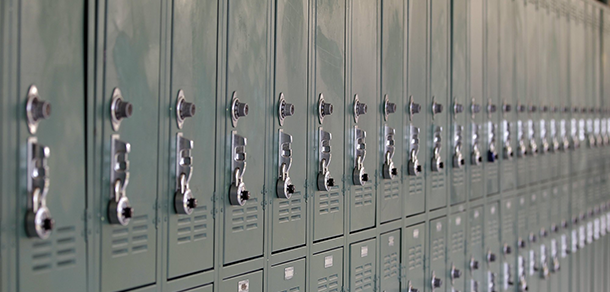
Related article: Hidden costs of traditional lockers
Evaluating smart locker ROI in contrast to old school lockers.
Higher ed is facing a ‘demographic cliff.’ According to data from the U.S. Census Bureau, starting in 2025 there will be a steep drop in traditional the college-age population. The reason? Between 2007 and 2020, the U.S. birthrate fell nearly 20%, this will likely translate to fewer students, more competition, and tightening revenues.
The new CBORD Insights™ Student Experience Survey collected data from hundreds of students and administrators at U.S. higher education institutions. A primary finding was that on- and off-campus dining revenue is a major concern as campuses prepare for this declining enrollment. Findings suggest that automation and analytics are key to addressing the issue.
“Most colleges and universities operate their foodservice as a standalone enterprise that is expected to turn a profit year after year,” said Dan Park chief executive officer of CBORD. “Dining services typically represent a significant revenue stream, and the disruption of that income has been a top concern for higher education leadership since 2020, when nearly all residential schools closed in response to COVID-19.”
Departmental leaders ranked exploring new revenue sources as their top initiative, while higher ups ranked it second only to labor-reducing automation.
Staffing shortages and predicted declining dining revenues, find administrators turning to automation to maintain service levels and preserve dining revenue. Initiatives to automate dining operations, create frictionless foodservice, and expand dining options are underway at half the institutions surveyed.
According to the study, half of the respondents have invested in automation in the last two years, and more than half expect to in the next two years. Departmental leaders ranked exploring new revenue sources as their top initiative, while higher ups ranked it second only to labor-reducing automation.
Potential new revenue streams cited include:
Still, it will not be easy. Further stressing auxiliaries, respondents expect incoming students – accustomed to remote learning – to be less likely to live and dine on campus.
“COVID-19 caused us to reevaluate some major aspects of our financial model and has led to a shift in how we think about on-campus dining,” said Mike Henderson of the University of Tennessee at Knoxville. “We are seeing many opportunities to use mobile technology to collaborate with our surrounding communities to provide dining services.”
To learn more about the results of this survey and other areas covered beyond dining, click here.
CR80News was onsite at last month’s Transact360, the annual Transact Campus user group conference. Great speakers, great networking, and a packed technology exhibit hall highlighted the three day event. Here are a few of the highlights from the expo:
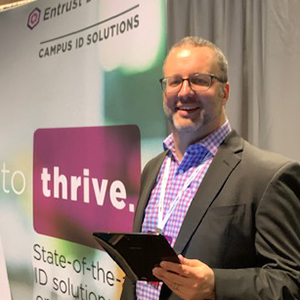 Retransfer printers, direct-to-card printers and distributed enrollment and issuance were the topics on tap for Entrust Datacard. Product Marketing Manager, Martin Hoff, said that modern card issuance is about “busting the lines.”
Retransfer printers, direct-to-card printers and distributed enrollment and issuance were the topics on tap for Entrust Datacard. Product Marketing Manager, Martin Hoff, said that modern card issuance is about “busting the lines.”
In the past, if a printer went down it could shut down the issuance process. With distributed issuance and the company’s TruCredential solution, you simply route the job to another location. Putting the card issuance software on a server enables this distributed issuance and lets the campus enroll cardholders anywhere on campus, not just in the card office.
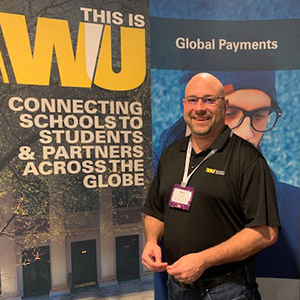 International students have added challenges when it comes to paying tuition at US institutions, and managing international payments is where Western Union thrives.
International students have added challenges when it comes to paying tuition at US institutions, and managing international payments is where Western Union thrives.
“We are fully integrated with Cashnet to help international students move money to pay tuition,” says Ben Kavalec, the company’s US director of sales.
Students make payments in their local currency and the institution gets paid in US dollars. The benefit for the student and their family is that they get preferential Western Union corporate rates for the transaction as it's a domestic payment for them rather than an international wire. If they went through their local bank to initiate the transaction, they would pay as an individual for an international wire at the highest rate.
Institutions also pay for receiving these international wires and the Western Union offering reduces these costs as well.
 Access control readers that can consume both the mobile credential and the physical card were on display at the Allegion booth. The company’s AD and NDE reader lines both accept mobile credentials, and Allegion can help campuses accept both iOS and Android devices in PACS environments.
Access control readers that can consume both the mobile credential and the physical card were on display at the Allegion booth. The company’s AD and NDE reader lines both accept mobile credentials, and Allegion can help campuses accept both iOS and Android devices in PACS environments.
Mark Casey, Director National Electronic Sales, says the biggest change this year is that people are making decisions when it comes to mobile first. “People were talking at the 40,000 foot level about what mobile could do, but now its shifted to action – how do we it and who do we involve."
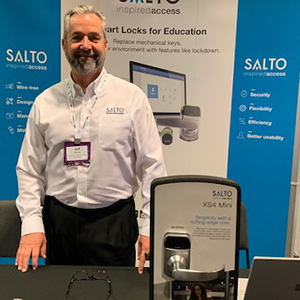 The mantra for access control provider Salto Systems has always been “data on card,” because they cleverly used the users’ cards to transport system-level data to their network of readers. Today that mantra has expanded to “data on phone,” as they recently rolled out mobile credential acceptance within their large deployed infrastructure at the University of Santa Clara.
The mantra for access control provider Salto Systems has always been “data on card,” because they cleverly used the users’ cards to transport system-level data to their network of readers. Today that mantra has expanded to “data on phone,” as they recently rolled out mobile credential acceptance within their large deployed infrastructure at the University of Santa Clara.
Jeff Wood, National Manager OEM at Salto, explains that their readers connect wirelessly not to find out if a cardholder has access to a door (they already know that based on data held on the card itself), but rather for managing system functions and enabling lockdown situations. “Data on card or data on phone still works with power outages as our locks are battery powered,” he says.
It’s also a cost effective install. “In a place like New York City, the end user cost could be $8,000 per door for a wired solution, but this gets that down to less than $1,000 and a five-minute install.”
A wide variety of biometric readers – from basic fingerprint-only readers to multi-factor devices and even contactless scanners – are serving higher ed installations thanks to IDEMIA.
The MorphoWave Compact is an option that is growing in popularity for use in unlimited access dining locations, rec centers and libraries, says Dave Gershenson, National Sales Manager for IDEMIA.
Gershenson has also seen a growing trend of scanning in and scanning out of academic facilities like libraries, as well as other on-campus locations. “In athletics, biometric access has become a recruiting tool to show off facilities to potential athletes,” he says.
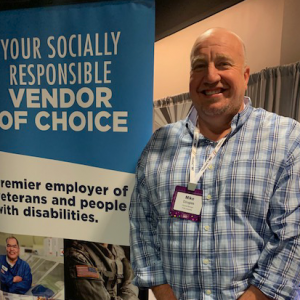 Many Transact readers and devices are made by a leading contract manufacturer that also happens to do good for our society.
Many Transact readers and devices are made by a leading contract manufacturer that also happens to do good for our society.
PRIDE Industries employs 3,400 people with disabilities across 16 states. That is more than half PRIDE’s workforce, so it's not just a PR move, but rather a core part of the company’s socially responsible mission.
According to Mike Douglas, PRIDE’s General Manager, PRIDE gives people a sense of purpose and gainful employment and that improves lives. Next time you use one of your Transact devices on campus, feel good knowing that lives were changed in its creation.
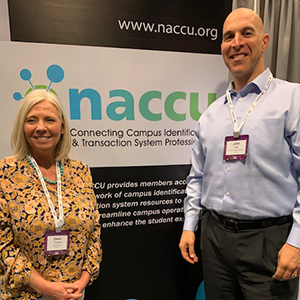 “We like to support our partners, and Transact360 and other user group events provide a great opportunity to connect and engage with the market,” says Dawn Thomas, Executive Director, NACCU.
“We like to support our partners, and Transact360 and other user group events provide a great opportunity to connect and engage with the market,” says Dawn Thomas, Executive Director, NACCU.
At the booth, Thomas, alongside membership engagement manager, John Ogle, met with a number of campus administrators – both members and potential members – to share association plans and learn what campuses need in terms of support.
NACCU provides both in-person and virtual educational opportunities throughout the calendar year targeted directly at higher education card and identity professionals.
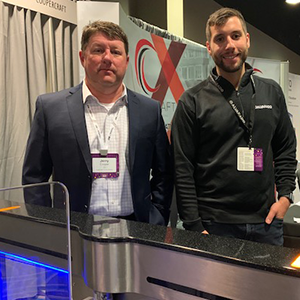 The sleek turnstiles from Alvarado would make a beautiful addition to any campus facility, and CooperCraft has installed them for Transact and other campuses.
The sleek turnstiles from Alvarado would make a beautiful addition to any campus facility, and CooperCraft has installed them for Transact and other campuses.
The optical barrier turnstiles are ideal for rec centers, student housing, dining halls and libraries, says Dan Gardner, Security Sales for Alvarado. He says that the turnstiles detect wrong-way entry and enforce one-to-one access by eliminating tailgating. It can also reduce staffing needs by removing the human the need for a person to scan ID cards at dining and other locations.
“We have turnstiles at Georgia State University providing data for their analytics on rec center usage,” explains Jerry Cooper, CooperCraft CEO. “They are great looking pieces and they can be customized with etching for each institution."
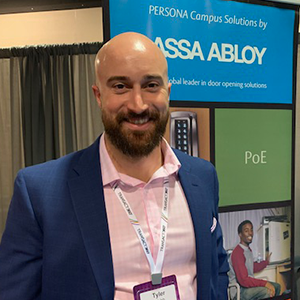 This spring, a new reader will join the Assa Abloy family that includes a keypad for situations when dual authentication is desirable.
This spring, a new reader will join the Assa Abloy family that includes a keypad for situations when dual authentication is desirable.
According to Tyler Webb, Assa Abloy Regional Manager, some campuses are seeking added security for residence halls. “We are hearing from institutions that are beginning to question if a single credential is enough for securing living spaces,” he says. "This new reader is designed to address that need."
CR80News was onsite at the 40th annual CBORD User Group Conference (UGC 2019) this week. There were many highlights, great educational sessions, and a packed technology exhibit hall. Here are a few of the highlights.
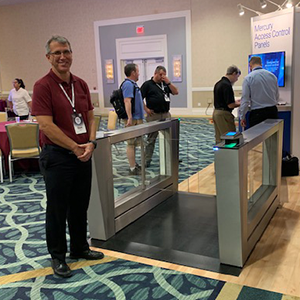 The sleek and secure turnstile from Smarter Security equipped with IDEMIA’s MorphoWave hand scanner was a hit with UGC attendees. The stainless steel and glass unit would look great in any high-end facility. It features anti-tailgating sensors with various alarms to warn staff of suspicious activity. According to Dave Beckwith, CBORD's product manager for integrated security, the primary use case is all-you-can-eat dining facilities. New firmware updates to the MorphoWave biometric scanner increase throughput by 20% and raise the number of patrons that can be enrolled in the unit from 20,000 to 100,000. The system is fully integrated with CBORD’s CSGold platform.
The sleek and secure turnstile from Smarter Security equipped with IDEMIA’s MorphoWave hand scanner was a hit with UGC attendees. The stainless steel and glass unit would look great in any high-end facility. It features anti-tailgating sensors with various alarms to warn staff of suspicious activity. According to Dave Beckwith, CBORD's product manager for integrated security, the primary use case is all-you-can-eat dining facilities. New firmware updates to the MorphoWave biometric scanner increase throughput by 20% and raise the number of patrons that can be enrolled in the unit from 20,000 to 100,000. The system is fully integrated with CBORD’s CSGold platform.
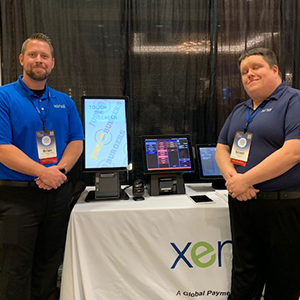 Nextep Systems showcased a series of kiosks for ordering and payment for CBORD food service locations. According to Brian Machiniak, Senior Relationship Manager for Nextep Systems, “self-service at the university level is a demand now.” The company’s range of self-order solutions support multiple methods for order and pay, and Machiniak stresses that flexibility is key because even on the same campus different dining operations require different setups. Nextep has been building self-service kiosks for 15 years, and Machiniak says clients typically see a 15% increase in the average ticket price due to the up-sell capabilities of the devices. Nextep Systems is part of the Xenial group of companies owned by Global Payments.
Nextep Systems showcased a series of kiosks for ordering and payment for CBORD food service locations. According to Brian Machiniak, Senior Relationship Manager for Nextep Systems, “self-service at the university level is a demand now.” The company’s range of self-order solutions support multiple methods for order and pay, and Machiniak stresses that flexibility is key because even on the same campus different dining operations require different setups. Nextep has been building self-service kiosks for 15 years, and Machiniak says clients typically see a 15% increase in the average ticket price due to the up-sell capabilities of the devices. Nextep Systems is part of the Xenial group of companies owned by Global Payments.
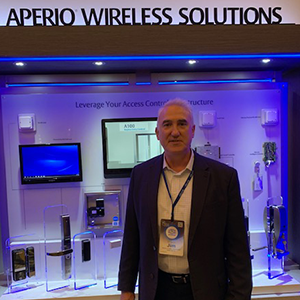 At the CBORD UGC event, Assa Abloy showed a compact version of its Aperio wireless locks that connect to mailboxes. The solution enables campuses to distribute mail to a secured box in a bank of mailboxes and restrict access to only the appropriate student ID card. Jim Primovic, Assa Abloy’s Director of Sales for Campus Electronic Access Control, demonstrated the solution and hinted at a major campus installation underway now.
At the CBORD UGC event, Assa Abloy showed a compact version of its Aperio wireless locks that connect to mailboxes. The solution enables campuses to distribute mail to a secured box in a bank of mailboxes and restrict access to only the appropriate student ID card. Jim Primovic, Assa Abloy’s Director of Sales for Campus Electronic Access Control, demonstrated the solution and hinted at a major campus installation underway now.
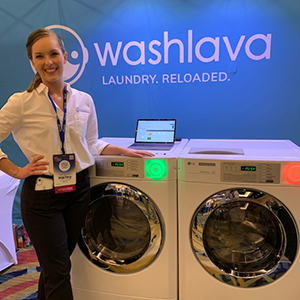 It looks like a glowing hockey puck affixed to a washer or dryer, but the Washlava device indicates when the machine is available, in use, or reserved by another user. Students interact with the laundry solution via a mobile app, reserving and paying for cycles. If they are standing in front of a machine, Bluetooth communication from their phone to the puck handles the transaction. They can also use the app to reserve a machine from their dorm or other location, locking it down for a specific number of minutes. According to Washlava's Hailey Hendrickson, MIT students pay for laundry cycles using their ID card's TechCash via MIT's CBORD system.
It looks like a glowing hockey puck affixed to a washer or dryer, but the Washlava device indicates when the machine is available, in use, or reserved by another user. Students interact with the laundry solution via a mobile app, reserving and paying for cycles. If they are standing in front of a machine, Bluetooth communication from their phone to the puck handles the transaction. They can also use the app to reserve a machine from their dorm or other location, locking it down for a specific number of minutes. According to Washlava's Hailey Hendrickson, MIT students pay for laundry cycles using their ID card's TechCash via MIT's CBORD system.
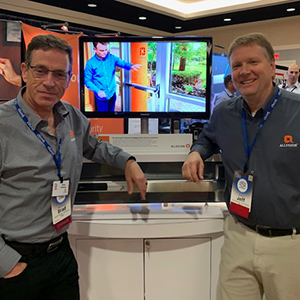 Crash bars are the metal locking mechanisms that span the width of many public access perimeter doors. Von Duprin is an industry leading provider of crash bars supplying 70% of the units in the higher education market, says Jeff Koziol, business development manager, campus software partner at Allegion. Allegion developed a retrofit kit for the popular crash bar that greatly improves campus safety. In normal operation, a staff person visits these doors and unlocks them so that students have unfettered access during normal operating hours. This unlocking process is known as “dogging” the doors. At the end of the day, the staff member goes back and “undogs” the doors, returning them to their locked state. Access control readers then require card access for entry. With the Allegion retrofit kit, Koziol explains that the undogging process can be automated such that many doors can be relocked from a central location. CBORD has integrated this new Allegion feature into CSGold.
Crash bars are the metal locking mechanisms that span the width of many public access perimeter doors. Von Duprin is an industry leading provider of crash bars supplying 70% of the units in the higher education market, says Jeff Koziol, business development manager, campus software partner at Allegion. Allegion developed a retrofit kit for the popular crash bar that greatly improves campus safety. In normal operation, a staff person visits these doors and unlocks them so that students have unfettered access during normal operating hours. This unlocking process is known as “dogging” the doors. At the end of the day, the staff member goes back and “undogs” the doors, returning them to their locked state. Access control readers then require card access for entry. With the Allegion retrofit kit, Koziol explains that the undogging process can be automated such that many doors can be relocked from a central location. CBORD has integrated this new Allegion feature into CSGold.
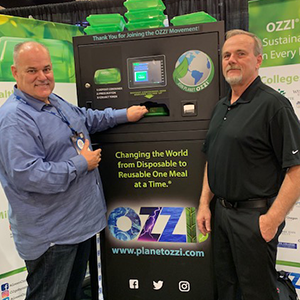 Around the world and on our campuses, the war against single use plastic is being waged. To-go containers from campus dining locations are a prime campus target. OZZI’s system of reusable containers and collection kiosks is already helping 90 colleges and universities eliminate waste and save money. “One OZZI container can replace 300 single use containers,” says Tom Wright, OZZI CEO. “An OZZI container costs less than $5 while each single use container costs 20-30 cents.” Campuses save money and help the environment. Typically a student redeems a token for a clean container and receives a token back when they return a dirty container to an OZZI kiosk. At the UGC event, OZZI demonstrated how CBORD has created a virtual token stored in the student card system, eliminating the need to keep track of physical tokens.
Around the world and on our campuses, the war against single use plastic is being waged. To-go containers from campus dining locations are a prime campus target. OZZI’s system of reusable containers and collection kiosks is already helping 90 colleges and universities eliminate waste and save money. “One OZZI container can replace 300 single use containers,” says Tom Wright, OZZI CEO. “An OZZI container costs less than $5 while each single use container costs 20-30 cents.” Campuses save money and help the environment. Typically a student redeems a token for a clean container and receives a token back when they return a dirty container to an OZZI kiosk. At the UGC event, OZZI demonstrated how CBORD has created a virtual token stored in the student card system, eliminating the need to keep track of physical tokens.
A world without physical card-based identification may still be years away, but that doesn’t mean it’s too early for innovation in the mobile ID space, including significant adoption for key use cases and applications.
Whether it is building on visual or optical security features, or empowering new business models and personalized user experiences based around identity as a service and electronic verification, mobile IDs hold the key to smart digital transformation and reduced friction for users while enabling additional privacy enhancing applications.
For the near future, both physical and digital credentials must coexist, so mobile IDs must combine security features that work across both physical and digital realms.
Security starts with simple scannable 2-D barcodes and rapidly advances from there. New security protections on the card include lightweight visual features that pair with advanced features that can be machine-readable in the field. The ideal security is linking the applicant’s face (selfie) to the official photo on record in the DMV database using biometrics.
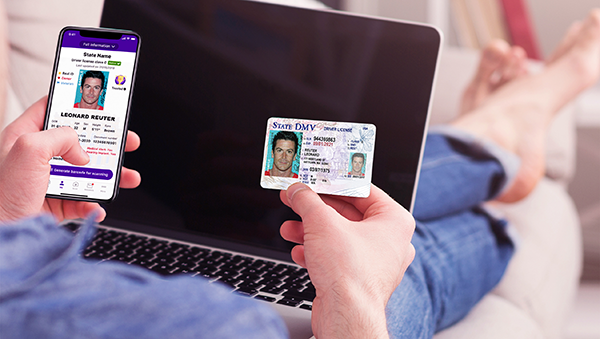
Mobile IDs will be machine-readable by dedicated readers or even an officer’s mobile phone. Encrypted and signed data packages can be decrypted and authenticated by approved software applications leveraging the ISO 18013-5 mobile ID standards.
To offer a familiar look, these mobile IDs include secure visual renderings that reflect the person’s physical driver’s license, but they also have additional security features that can be authenticated by law enforcement. The mobile driver’s license enhances both security and convenience. For example, a citizen can tap on their phone screen and show features – such as 3-D portraits that move back and forth or animated guilloche patterns that change their appearance – to law enforcement without the officer having to go back and forth to the patrol car.
Mobile IDs will be machine-readable by dedicated readers or even an officer’s mobile phone. Encrypted and signed data packages can be decrypted and authenticated by approved software applications leveraging the ISO 18013-5 mobile ID standards. This can be accomplished through the mobile ID app via the Internet, locally and directly via Wi-Fi Aware, Bluetooth or near-field communication. Additional standards such as Open ID Connect (OIDC) are included in the mobile ID app to empower logical access to web and mobile applications, enabling users to login using their mobile driver’s license.
In addition to security benefits, mobile credentials also enhance citizen privacy.
“In well-designed mobile ID systems, no personally identifiable information is stored in the cloud service,” says Darrell Geusz, Senior Director of Product Management, Digital Identity for IDEMIA. “Identity data only stays in two places – on file with the government system of record and on your phone. In addition, the user must have the ability to consent to what information is being shared and when.”
There is good reason to encourage investment in mobile IDs. As the culture is changing, so is the role of the typical motor vehicle office.
With driving among the younger generations at an all-time low, and with the emergence of ride-sharing and autonomous vehicles, the role of the DMV in managing driving privileges and enforcement is becoming less pronounced.
“DMVs recognize the potential contribution and significance of their regulated identity proofing and identity management services in the digital transformation of our society, and how they need to extend their reach to play a key role,” says Geusz.
With a new digital and mobile identity in place, states can interact with citizens in new ways with the help of the DMV.
With driving among the younger generations at an all-time low, and with the emergence of ride-sharing and autonomous vehicles, the role of the DMV in managing driving privileges and enforcement is becoming less pronounced.
An obvious first step would be through an interaction like opening the lines of communication about a pending license renewal. The mobile driver’s license could also serve as the point of contact to notify a speeding ticket recipient that points were added to the license and also when those points come off — reminding the driver to contact their insurance provider to bring their rate down.
Another goal of the mobile driver’s license is to get people out of line at the DMV.
Say, for example, you were selling your car. At least one state is piloting a program that will complete the title transfer without requiring the seller or the buyer to step foot in the DMV. States also have plans to enable name or address changes, renewals, and fee collection within the mobile ID app.
Down the road, it is possible that a sufficiently secure mobile driver’s license could be used to register to vote — or maybe even facilitate voting directly in the mobile ID app.
“Government issued mobile IDs like the mobile driver’s license can become the backbone for all e-government functions,” says Geusz. “Eventually it will become the citizen app, a portal to conduct identity-centric interactions with the government.”
A government-backed or government-issued mobile ID, such as the mobile driver’s license, could also facilitate private sector transactions such as opening a bank account, checking into hotels, renting cars, or booking airline tickets. All these services require a secure identity and beg for the flexibility of a mobile ID.
Enabling VIP and concierge services, as well as interacting with an organization’s infrastructure, is also a key benefit of implementing mobile IDs, especially as the Internet-of-Things (IoT) continues to grow.
Despite all the new services enabled by a mobile driver’s license, the credential’s original function for driving privileges and law enforcement use cases are also enhanced.
[blockquote align='right']Security increases as the officer now knows who is in the vehicle before approaching the motorist. Then, the officer could further affirm identity and validate credentials in a peer-to-peer function using their own mobile device or a dedicated reader.[/blockquote]
Take a typical traffic stop where an officer pulls over a vehicle. The driver’s mobile app could communicate using Bluetooth or Wi-Fi before the officer even steps out of the cruiser.
Security increases as the officer now knows who is in the vehicle before approaching the motorist. Then, the officer could further affirm identity and validate credentials in a peer-to-peer function using their own mobile device or a dedicated reader.
“Mobile driver license implementations incorporate the secure ISO 18013-5 standard and available verification SDKs and web-based services to enable law enforcement software vendors to take advantage of electronic verification right away,” says Geusz.
In certain circumstances, such as with a large semi-trailer truck, distance issues could make communication difficult. At all times, visual inspection is still an option and of course, the officer can always call in the number or run it through DMV and law enforcement databases as they do today.
This is all possible because of the security and functionality that are being built into the mobile driver’s licenses.
By supporting security, convenience, service to citizens, and privacy, mobile IDs such as mobile driver’s licenses have a lot to offer over their physical predecessors. The solution is to build the modern mobile ID into an omni-channel tool, unifying the online and physical world.
Though details are not available at this time, CR80News has confirmed that Assa Abloy is working with Apple on their efforts to add student ID cards to Apple Wallet. The company shared the following statement exclusively with CR80News:
“This fall Apple is bringing the ability to add student ID cards to Apple Wallet. ASSA ABLOY are excited to be working with Apple to help facilitate some of the new capabilities. When student ID cards are added to Wallet on iPhone or Apple Watch, students and faculty will have an easier and more convenient way to open doors, make payments on and around campus and enable contactless student ID functionality.”
Stay tuned to CR80News as we will continue to update as more information is available.
The rumor mill always starts turning ahead of an Apple event, and it was no different in the lead in to the company’s Worldwide Developer Conference (WWDC) this week. Among the rumors again this year, was the anticipated opening up of the NFC chip’s capabilities to enable additional services to use the short-range communication protocol.
Anyone who has followed Apple’s work with NFC will have heard this before, so while it’s nice to hear Apple discuss NFC, we were naturally skeptical of what would be on show at WWDC. Still, we watched in anticipation that this year’s Developer Conference would provide some long awaited news regarding NFC and the student ID card. We got a glimpse.
The student ID card officially made its appearance on the Apple stage in the watchOS portion of the keynote. Apple Technology VP, Kevin Lynch, announced that this coming fall the student ID card will soon be available to add to iPhone and Apple Watch for access and payments on campus. The integration will enable students to add their campus card to the Wallet app on iPhone or Apple Watch to support access to places like dorms or libraries, as well as support payments at locations across the campus.
Lynch went on to reveal that the initiative will launch this fall. According to Apple documentation, "the program launches with Duke, the University of Alabama and the University of Oklahoma this fall. Johns Hopkins University, Santa Clara University and Temple University will bring the capability by the end of the year."
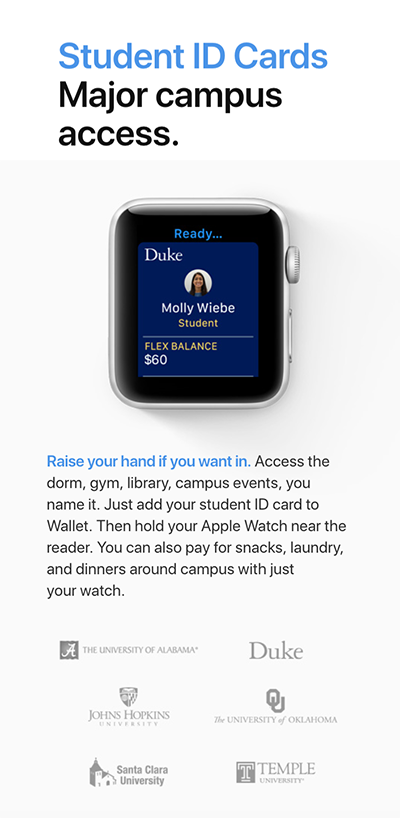
While the prospect of iPhones and Apple Watches being used as credentials on college campuses is certainly exciting, there is also a trend in the early adopter campuses. Though Blackboard wasn’t mentioned by name in the keynote, each of the flagship campuses listed on stage is a Blackboard Transact client and the company has now confirmed its role alongside Apple in bringing this technology to the campus card industry.
When reached, Blackboard indicated additional details will follow, but responded with the following:
“We’re excited to confirm that we’re working with Apple to help bring the ability to add student ID cards to Apple Wallet. Beginning this fall, students, faculty and staff will have the opportunity to seamlessly access facilities and make payments at locations on and around campus with the iPhone and Apple Watch. This capability offers students and the broader campus community heightened security and extraordinary convenience, taking advantage of compatible terminal/reader devices from Blackboard.”
Apple’s brief acknowledgement of student ID card being used with its flagship hardware is a bit of a watershed moment for not only Blackboard, but for the campus card industry as a whole.
Blackboard has been pushing campuses to NFC since it shipped its first NFC-capable readers in 2010. Since then hundreds of campuses have deployed tens of thousands of the company’s NFC readers for access control, attended and unattended payments and privilege control. To date, the credential they have used has been the NFC compliant contactless card, but both the company and its campus clients have always looked to the day when they could also use the mobile phone as a student ID credential.
The challenge until now has been that only Android phones have offered support for this feature via the handset’s embedded NFC chip. Apple added NFC to the iPhone 6 in 2014, but restricted its use to only to its own, proprietary Apple Pay service and then later to limited tag reading functions. Until this announcement, using NFC on the iPhone in “card emulation” mode – that is, to act like an ID card in campus card systems – was prohibited.
As we in the campus card market understand better than perhaps any other market, multi- application is crucial. Modern students demand that their campus credentials support the full range of transactions across the campus, from door access to vending and privilege tracking to dining hall entry and payments. Today’s keynote was an important step in the right direction.
Immediately following the WWDC event, Apple added a review of the major announcements online. Under a header "Student ID Cards. Major Campus Access" Apple describes the upcoming feature: "Access the dorm, gym, library, campus events, you name it. Just add your student ID card to Wallet. Then hold your Apple Watch near the reader. You can also pay for snacks, laundry, and dinners around campus with just your watch.”
The universities highlighted on stage at WWDC have been hard at work with the technology for some time now. They, along with countless other peer institutions across the country deployed NFC-capable readers believing this day would come. And while additional details will emerge in the coming weeks and months detailing how this service will work in the wild, today’s announcement offers the first validation of this strategy.
There’s a growing demand among college students for smart lockers – a safe place on campus to store expensive belongings like smart phones, laptops and tablets while they’re taking a test or hitting the gym, a lab or a campus event. Equipping lockers with contactless technology can offer students a smart option for storing their valuables without having to remember a locker combination or wait in line for a rental. Instead, students simply tap their existing contactless campus card to engage the secure contactless locker. But how does the smart locker ROI – or contactless locker ROI – equation come together for campuses?
[blockquote align='right']Institutions can make money off rental fees, and there are solid cost savings on the manpower needed to manage and maintain smart lockers[/blockquote]
The return on investment can be significant for universities that install contactless lockers. The potential exists for institutions to make money off rental fees, and there are solid cost savings on the manpower needed to manage and maintain the lockers. “A networked locker system eliminates virtually all the staff time required for locker management, as students no longer need help obtaining or using the system,” says Gerhard Pichler, business development manager for Gantner Technologies.
For decades, Gantner has delivered contactless technology for lockers in universities, athletic clubs, spas, hospitals and corporate centers around the globe. Now the company is bringing the technology to colleges and universities in North America.

Related article: Hidden costs of traditional lockers Evaluating smart locker ROI in contrast to old school lockers. |
In addition to revenue and cost savings potential, smart lockers can provide universities with intangible benefits as well. Contactless lockers can serve as a recruitment tool, positioning the institution as modern and tech-minded. And both students and their parents appreciate the security aspect of the lockers, which can feature alarm functions to protect electronics and other valuables.
The key to contactless smart lockers is that they are networked and communicate in real-time with the management software. This enables efficient assignment, monitoring and revocation. Gantner’s locker management software also offers occupancy monitoring, which helps the institution maximize locker rentals by identifying unused lockers and overstays.
Contactless lockers are still relatively new to U.S. higher education market. Charting the course domestically is Northeastern University, where in 2016 Gantner installed more than 1,200 networked, contactless lockers.
There’s a growing demand among college students for smart lockers – a safe place on campus to store expensive belongings like smart phones, laptops and tablets while they’re taking a test or hitting the gym, a lab or a campus event. Equipping lockers with contactless technology can offer students a smart option for storing their valuables without having to remember a locker combination or wait in line for a rental. Instead, students simply tap their existing contactless campus card to engage the secure contactless locker. But how does the smart locker ROI – or contactless locker ROI – equation come together for campuses?
[blockquote align='right']Institutions can make money off rental fees, and there are solid cost savings on the manpower needed to manage and maintain smart lockers[/blockquote]
The return on investment can be significant for universities that install contactless lockers. The potential exists for institutions to make money off rental fees, and there are solid cost savings on the manpower needed to manage and maintain the lockers. “A networked locker system eliminates virtually all the staff time required for locker management, as students no longer need help obtaining or using the system,” says Gerhard Pichler, business development manager for Gantner Technologies.
For decades, Gantner has delivered contactless technology for lockers in universities, athletic clubs, spas, hospitals and corporate centers around the globe. Now the company is bringing the technology to colleges and universities in North America.

Related article: Hidden costs of traditional lockers Evaluating smart locker ROI in contrast to old school lockers. |
In addition to revenue and cost savings potential, smart lockers can provide universities with intangible benefits as well. Contactless lockers can serve as a recruitment tool, positioning the institution as modern and tech-minded. And both students and their parents appreciate the security aspect of the lockers, which can feature alarm functions to protect electronics and other valuables.
The key to contactless smart lockers is that they are networked and communicate in real-time with the management software. This enables efficient assignment, monitoring and revocation. Gantner’s locker management software also offers occupancy monitoring, which helps the institution maximize locker rentals by identifying unused lockers and overstays.
Contactless lockers are still relatively new to U.S. higher education market. Charting the course domestically is Northeastern University, where in 2016 Gantner installed more than 1,200 networked, contactless lockers.
Under the name HID FARGO Connect, HID Global unveiled what it calls the industry’s first cloud-based card issuance solution for the personalization of both ID cards and mobile credentials.
If you present an ID card printer to the Internet it is an unsecured device so you need to protect it ... The HID FARGO Connect Console serves as the secure element between the printer and the network.
By replacing the old paradigm of standalone printers tied to dedicated PC workstations, this new offering enables secure personalization of ID cards from any location and from any web-enabled device. It lets system administrators remotely monitor and manage consumables, as well as introduces greater visibility into the entire credential issuance process.
“HID FARGO Connect is the biggest innovation that the ID card issuance industry has seen in more than a decade, and with it HID is changing the way cards and credentials are issued forever,” says Craig Sandness, Vice President and Managing Director of Secure Issuance with HID Global.
In traditional card printing environments, one ID card printer was typically controlled by one dedicated workstation. In this new environment, ID card printers are connected to the Internet just like networked paper printers commonly are in offices. For secure ID printers, this topology has been largely avoided for its security limitations.
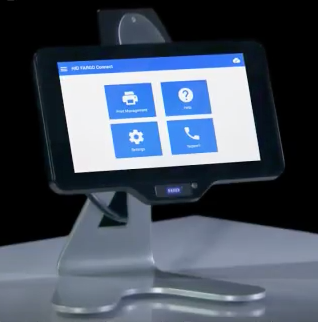
The HID FARGO Connect consoles serves as the secure element between the cloud and the Internet-connected ID card printers
With HID FARGO Connect ID card printers are edge devices on the network, or more accurately on the cloud, and can be communicated with through secure web-enabled devices.
“If you present an ID card printer to the Internet it is an unsecured device so you need to protect it,” says Sandness. “The HID FARGO Connect Console serves as the secure element between the printer and the network.”
This physical piece of equipment, called the HID FARGO Connect Console, functions as a gateway between the cloud and the printers, holding the Identrust digital certificates and ensuring that only trusted instructions are delivered to the printers. According to Sandess, one console can support numerous printers, and he says that they have already driven as many as six printers from a single console with the capacity to run more.
He adds that they never store personally identifiable information (PII) in the cloud environments.
Aligning with the popular Apple Store concept and experience, card office employees outfitted with tablets now meet students proactively. The personalization data and photo can be captured from anywhere in the office or out.
Today, the solution is able to support a couple of key one card and security systems providers, but the intent is to open it up to the entire channel, explains Robin Tandon, Director of Product Marketing of Secure Issuance at HID Global.
The HID Global physical identity and access management platform, Quantum Secure, is an early example of a security solution that supports HID FARGO Connect. In the education vertical, one of the leading providers of campus ID card solutions, CBORD, is already supporting the technology.
Among the first issuers to use HID FARGO Connect is Kent State University, a CBORD campus card client. According to university officials, the issuance of thousands of student IDs during orientation has been streamlined and the student experience improved through its shift to the new cloud-based approach.
Universities across the country issue millions of pieces of plastic every year so that students can make purchases, access facilities and prove identity for applications both on and off campus.
The vast majority of cards issued in higher education are made exclusively from polyvinyl chloride – or PVC. This is the cheapest and most common card material available, and for applications where the use is short term and counterfeiting is of little concern, 100% PVC could be a fine choice.
But when a card needs greater lifespan and increased security, universities may want to consider composite cards made from advanced card materials. These materials can add durability to the card and make them more difficult to counterfeit. The trade off is an increased cost per card, but in virtually every other secure card market, issuers are finding the benefits exceed the added cost.
Many assume the standard CR80-sized plastic card is a single piece of plastic die cut from a large sheet, but the truth is a bit different, says Pierre Scaglia, global segment manager for Secure Credentials at PPG Industries.
A typical card issued by a campus card office includes multiple layers of white plastic made from PVC with a clear PVC layer on top. The clear layer contains the variable information, such as photo and demographic information, he explains. The card can also include an overlay or laminate layer with a security element such as a hologram that is added during the personalization process.
If the card includes electronics – such as a contactless chip and antenna array – those are sealed in a sheet of plastic and placed in between the PVC core layers, Scaglia explains.
“This basic PVC card offers fairly low levels of security,” he says, alluding to the fact that it can be easily and inexpensively counterfeited.
PVC cards are everywhere, likely due to their extremely low cost. They are personalized using readily available desktop printers, which are available online from countless resellers and auction sites along with the PVC cards and printer ribbons required to create extremely passable fakes.
In summary, 100% PVC cards are great for fast, convenient and low cost ID creation, but they are susceptible to fraud and rank low on the durability scale.
Instead of constructing cards only with layers of PVC, composite cards layer different materials to add advanced features and combat counterfeiters. Composites are the go to options in the high-security identity document market and are being used in driver licenses and national ID cards across the U.S. and around the globe.

